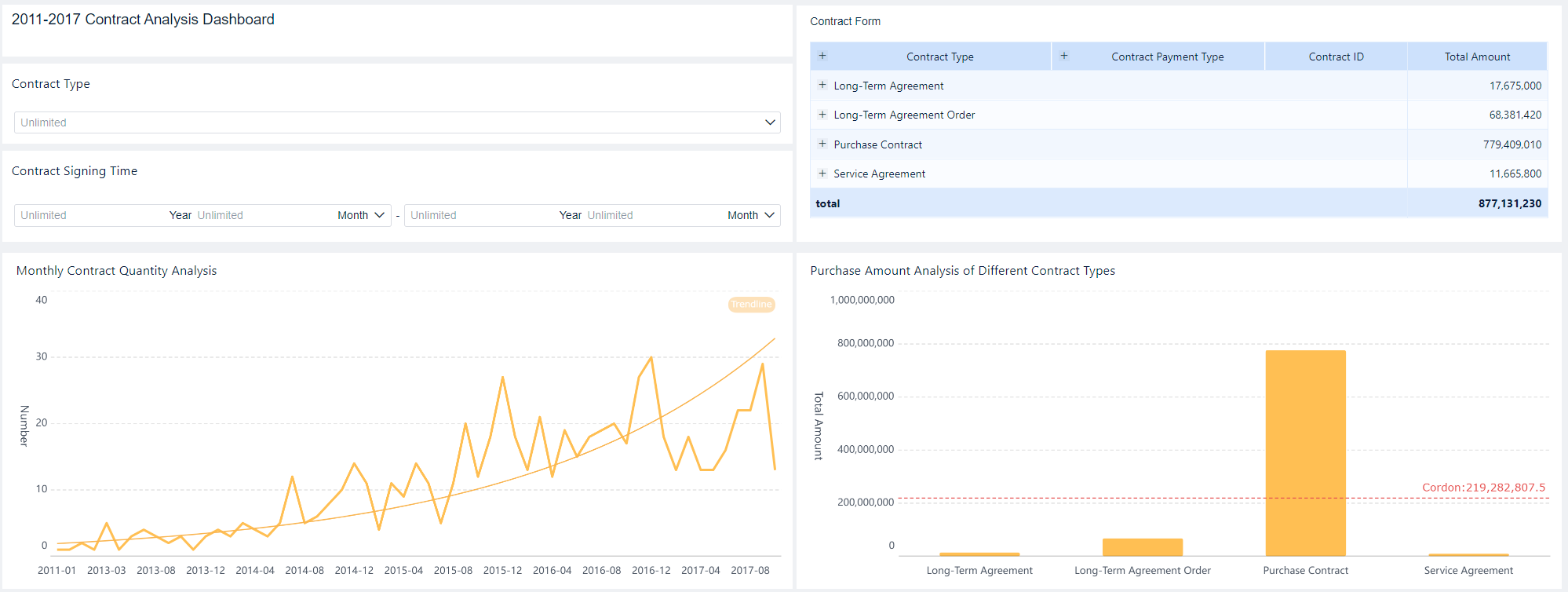Overview
Version
FineBI Version | Multilingual Configuration Plugin Version |
6.0.19 | V2.2.0 |
Application Scenario
In an enterprise, when you need to display dashboard content of different languages, you want the dashboard can display multiple languages to reduce creation and maintenance costs, as shown in the following figure.


This document introduces how to set template internationalization and achieve template language switchover in a dashboard.
Supported Range
 Note:
Note:1. Content switching within the supported range requires adding keys and corresponding language translations in System Management > Language Configuration. For details, see section "Multilingual Key Addition."
You can refer to the following table after adding the keys and the corresponding translations. The text content marked with fi18n[] means that the language of the content can be switched through the function fi18n[], and the language of others unmarked can be switched through an automatic read of the built-in keys on the platform.
2. Multilingual switchover can be achieved only when the keys are fully matched and recognized. For details, see "Key Matching Rules."
Classification | Supported Range | Example |
Widget | Widget Title (fi18n[])
|  |
Widget Content | ||
Table | Table Title (fi18n[])
|  |
Table Header | ||
Table Content | ||
Chart | Chart Title (fi18n[])
|  |
Category/Series Name Legend/Indicator Name Axis Name Chart Label Chart Prompt Trendline Name Cordon Name | ||
Other | Dashboard Name |  |
Key Matching Rules
General Rules
For scenarios where the fi18n[] function needs to be used in rich text, you can refer to the scenarios marked in section "Supported Range." This section introduces the matching rules when fi18n[] is not used: Multilingual switchover can be achieved only when the keys (including symbols and spaces) are fully matched and recognized on a per-line basis.
Scenario | Rule | Example |
Text | In a single-line scenario, the text content (including symbols and spaces) of the line needs to be a key. | 1. If Purchase Quantity is entered as a key, then Purchase Quantity can be recognized and switched, but Purchase Quantity: cannot be recognized.
2. If you want Purchase Quantity: can be recognized, then Purchase Quantity: needs to be entered as a key.
|
In a multiple-line scenario, each line is recognized as a separate key. | In the line break scenario, Purchase Quantity can be recognized.
| |
Text and Field | If there are dimension/indicator fields in the rich text content on a line, the text will be split by the fields. The text before and after the fields can be recognized as separate keys. For example, If key1 is before a field and key2 is after the field, both key1 and key2 can be recognized. Similarly, key1 and key2 need to meet the requirement of full word matching (including symbols and spaces). | If Purchase Quantity: and (count) are entered as keys, then the two keys can be recognized in the text form Purchase Quantity: + field + (count).
|
Exceptional Cases
In the chart prompt, for the scenario where key1:key2 is used, if the keys are separated by : (with no spaces around it), both key1 and key2 can be recognized.
 Note:
Note:Prerequisite
You have obtained the plugin at https://community.finereport.com/plugin/?id=117.
For details about how to install the plugin in the designer, see Plugin Management.
Example
This document takes the creation of Contract Analysis Dashboard as an example. You can download the resource Contract Fact Table.xlsx.
Resource Addition
Download the Excel file and add it to Public Data.

Create an analysis subject, as shown in the following figure.

Table Addition
Open the created analysis subject, click the component tab, drag the fields Contract Type, Contract Payment Type, and Contract ID into Dimension, and drag the field Total Amount into Indicator, as shown in the following figure.

Chart Addition
Adding a Column Chart
1. Click the ![]() button to add a new component, select Partitioned Column Chart as Chart Type, drag the field Contract Type into Horizontal Axis, and drag the field Total Amount into Vertical Axis.
button to add a new component, select Partitioned Column Chart as Chart Type, drag the field Contract Type into Horizontal Axis, and drag the field Total Amount into Vertical Axis.

2. Add the label and prompt.

3. Add the cordon.

Adding a Line Chart
1. Click the ![]() button to add a new component, select Partitioned Line Chart as Chart Type, drag the field Contract Signing Time into Horizontal Axis, and drag the field Count into Vertical Axis.
button to add a new component, select Partitioned Line Chart as Chart Type, drag the field Contract Signing Time into Horizontal Axis, and drag the field Count into Vertical Axis.

2. Add the trendline.

Dashboard Creation
1. Click the ![]() button to add a dashboard, drag the created components into the dashboard, and modify the component titles to the format fi18n[Component Title]. Take the table as an example, as shown in the following figure.
button to add a dashboard, drag the created components into the dashboard, and modify the component titles to the format fi18n[Component Title]. Take the table as an example, as shown in the following figure.

2. Click Other, drag Text Component into the dashboard as the dashboard title, and set the content of the component to 2011-2017 fi18n[Contract Analysis Dashboard], as shown in the following figure.

3. Click Filter Component, drag Text Drop-Down into the dashboard to filter data of the contract types, and drag Year-Month Interval into the dashboard to filter data of the contract signing time, as shown in the following figure.

Set the title of the Text Drop-Down component to fi18n[Contract Type], as shown in the following figure.

Set the title of the Year-Month Interval component to fi18n[Contract Signing Time], as shown in the following figure.

Multilingual Key Addition
Choose System Management > Language Configuration and click Import to import the corresponding keys.
Download the Excel file Language.xlsx.

After you successfully import the file, you can view all the keys on the decision-making platform. You can add, delete, and modify the keys.

Effect Display
Click the language switchover button in the upper right corner of the page to switch the language, as shown in the following figure.





